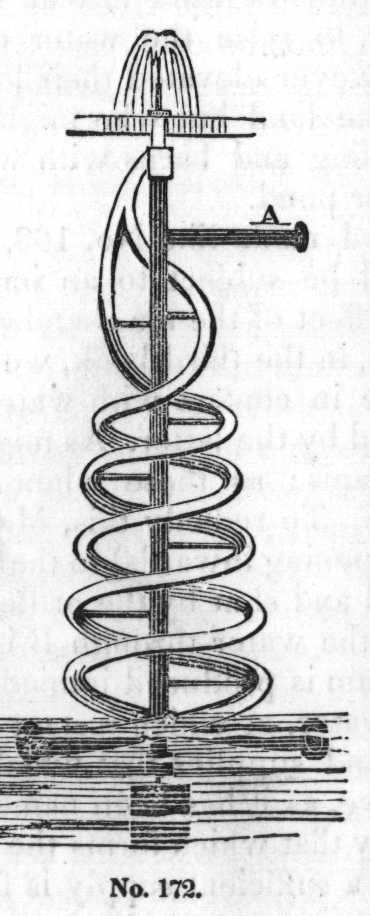
Thomas Ewbank. Hydraulics. 16th ed., 1876. Fig. 172.
Image public domain
Rolling Ball Technology
An Online Technical Reference Devoted to
Rolling Ball Sculptures, Clocks, and other Devices
By Members of the rolling-ball@lemur.com List
By David M. MacMillan
By "pressurized screw" I mean any screw-type lifting device in which, if the pressure pushing or supporting the balls in the screw's helix were removed, the balls would fall back. This may be distinguished from an archimedean screw, in which the balls are held in place by the screw, not by lower balls.
The "Innovation Station" interactive exhibit at the Henry Ford Museum, Dearborn, Michigan, employs two identical screw-type devices to lift balls. These two devices are hand-powered (by members of the audience). They are vertical helical screws encased in a clear plastic tube; they're perhaps a foot or two in diameter and 20 feet or so high. At the bottom end, they dip into a large bin of balls which is at least partly restrained by an enclosing cage. Turning these screws lifts a continuous line of balls upwards along the helix. Balls are prevented from rolling back down the helix by the ball behind them, and so forth down to the bin of balls. Presumably this bin exerts enough pressure to maintain a line of balls in the helix.
Thomas Ewbank's Hydraulics includes an illustration of a double "conical helix" of tubes intended to lift water by virtue of being rotated, presumably rapidly, against a body of water. I'm not sure that "dynamic" is the appropriate term here, but this does seem to use pressure in a different manner than the "static" pressurized screw noted above.

Thomas Ewbank. Hydraulics. 16th ed., 1876. Fig. 172.
Image public domain
With the exception of material noted as being in the public domain, the text, images, and encoding of this document are copyright © 1997-1998 by their author(s) and editor(s): David M. MacMillan.
This document is licensed for private, noncommercial, nonprofit viewing by individuals on the World Wide Web. Any other use or copying, including but not limited to republication in printed or electronic media, modification or the creation of derivative works, and any use for profit, is prohibited.
This writing is distributed in the hope that it will be useful, but "as-is," without any warranty of any kind, expressed or implied; without even the implied warranty of merchantability or fitness for a particular purpose.
In no event will the author(s) or editor(s) of this document be liable to you or to any other party for damages, including any general, special, incidental or consequential damages arising out of your use of or inability to use this document or the information contained in it, even if you have been advised of the possibility of such damages.
In no event will the author(s) or editor(s) of this document be liable to you or to any other party for any injury, death, disfigurement, or other personal damage arising out of your use of or inability to use this document or the information contained in it, even if you have been advised of the possibility of such injury, death, disfigurement, or other personal damage.
All trademarks or registered trademarks used in this document are the properties of their respective owners and (with the possible exception of any marks owned by the author(s) or editor(s) of this document) are used here for purposes of identification only. A trademark catalog page lists the marks known to be used on these web pages. Please e-mail dmm@lemur.com if you believe that the recognition of a trademark has been overlooked.
Version
1.1, 1998/06/20.
Feedback to dmm@lemur.com
http://www.database.com/~lemur/rbt-pressurescrew.html
Go to the: